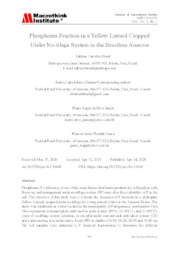Phosphorus fraction in a yellow latosol cropped under no-tilage system in the brazilian Amazon.
Phosphorus fraction in a yellow latosol cropped under no-tilage system in the brazilian Amazon.
Author(s): BRASIL, E. C.; DANTAS, R. C. R.; SILVA JÚNIOR, M. L. da; GAMA, M. A. P.
Summary: Phosphorus (P) deficiency is one of the main factors that limits productivity in Brazilian soils. However, soil management under no-tillage system (NT) may alter the availability of P in the soil. The objective of this study was to evaluate the dynamics ofP fractions in a dystrophic Yellow Latosol, cropped under no-tillage for a long period of time in the Amazon Biome. The study was conducted on a farm located in the municipality of Paragominas, southeastern Pará. This experiment evaluated plots cultivatedin plots at nine (NT9), 11 (NT11) and 13 (NT13) years of no-tillage system adoption, in one plot under conventional cultivation system (CS) and a surrounding area under native forest (NF) at depths of 0-10, 10-20, 20-30 and 30-40 cm. The soil samples weresubjected to P chemical fractionation to determine the different ractions. The soil management systems showed differential capacity of P accumulation. In the areas under no-tillage, P is accumulated in the toplayer and drastically reduced with depth, while in CS, this reduction is less pronounced. In the 0-20 cm depth layer during the adopted period of the no-tillage system, it was observed an increase in the content of inorganic phosphorus extracted by resin and 0.5 M NaHCO3(PiAERand PiBIC) and organicphosphorus extracted by 0.5 M NaHCO3(PoBIC), fractions considered as available for Biomass. Regardless of the year of adoption, the no-tillage system was superior to CS and NF. This was also observed for the inorganic and organic fractions extracted by NaOH 0.1M(PiHid-0.1and PoHid-0.1)and inorganic fraction extracted by HCl 1M (PiHCl).
Publication year: 2020
Types of publication: Journal article
Unit: Embrapa Eastern Amazon
Keywords: Fósforo, Latossolo Amarelo, No-tillage, Phosphorus, Plantio Direto, Profundidade, Soil depth, Yellow Latosol
Observation
Some of Embrapa's publications are published as ePub files. To read them, use or download one of the following free software options to your computer or mobile device. Android: Google Play Books; IOS: iBooks; Windows and Linux: Calibre.
Access other publications
Access the Agricultural Research Database (BDPA) to consult Embrapa's full library collection and records.
Visit Embrapa Bookstore to purchase books and other publications sold by Embrapa.

